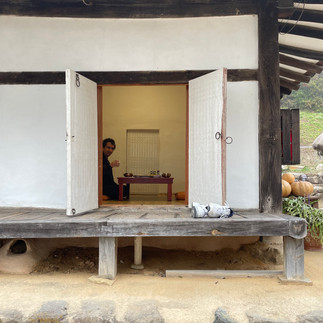I’ve written before about the extremes of ancient and modern in South Korea. Seoul is filled with uber-modern buildings and state of the art technology. At the same time, Koreans can track their families back 700 years or more. (Take that, Ancestry.com!) Last week we traveled to Hahoe, a village that has been occupied by the Ryu clan since the 1400s. Here’s a glimpse.
It is a small riverside village, home to about 700 people. There are no schools or stores; people must travel outside the village for all services. The homes have either tile or thatched roofs. Small alleys connect the houses. The old world environment is disrupted only by the occasional satellite dish or historic marker in Korean English and Chinese.
The shining star of the Ryu family was Ryu Seong-ryong, a famous Joseon scholar in the 1500s, who became chief counselor to the king. When he retired from government service, he built Okyeon Paviliion, a library and retreat across the river Hahoe village where he spent his final years.

We stayed at Okyeon Pavillion, now a small inn run by the 16th generation descendent of Ryu Seong-ryong. He can trace his family history through genealogy books that get passed to the eldest son of each generation.
The inn was updated with electricity. Each room had its own modern bathroom, but they were in a separate building. My Long Island-born husband considered it a night hike to go there after bedtime!
Rooms are heated with the traditional Korean floor heating. For thousands of years, Koreans have used wood burning furnaces to push heat under floors. It is an early predecessor of radiant heating. Our room heater was electric, but some rooms at Okyeon Pavilion are still still heated by burning wood. (Our proprietor told us it is much more efficient than electricity.)
Our cozy room had futons on the floor instead of a bed, and traditional rectangular pillows. As an insomniac, I approached this with trepidation, but found it cozy and comfortable. Instead of glass, the windows were covered with hanji –a traditional paper made from mulberry bark. The paper can be treated with oil to be made waterproof. Today, hanjimaking is a respected Korean art form. Here is an example.

Breakfast was a Korean feast consisting of dried fish, partially dried fish, a scallion pancake, soup, multiple little salads, two kinds of kimchi, and of course rice. We sat on the (heated) floor at a low table. Fortunately for me, there was coffee available. The buildings, landscaping and views all created a sense of calm and peace.
As we drove back into Seoul, with its traffic jams, bright lights, and towering buildings, we appreciated the peacefulness of an earlier time.
























Fascinating, as always. It looks very clean and peaceful.
It looks lovely. Is the library still there?
Lovely adventure. Love the simplicity!
Thanks again for another fascinating post, Amy. Love the pictures! Given that there are no stores in the village, I'm curious how far they have to go for food shopping, etc. The pictures don't show roads and cars. Do the people have cars parked outside the village?